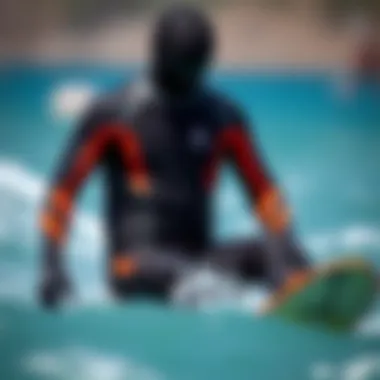Wet Suits vs. Dry Suits for Kiteboarding: Key Differences


Intro
Kiteboarding is more than just a sport; it’s an exhilarating dance with nature and the elements. As any experienced rider will tell you, understanding your gear is not merely a matter of preference; it's essential for safety and performance. When it comes to staying comfortable in the water, the choice between wet suits and dry suits is at the forefront of that gear decision.
For kiteboarders, the right suit hinges on various conditions such as water temperature, wind speed, and personal comfort. Each suit has unique characteristics that can significantly affect your experience on the water, whether you're just dipping your toe in or tearing up waves with technical maneuvers. Our journey will clarify the differences between these two types of suits, ultimately guiding you to the right choice depending on your practice and the enviroment.
Prelude to Kiteboarding Apparel
Kiteboarding is more than just a hobby; it's a thrilling adventure that requires proper gear to ensure safety, performance, and enjoyment on the water. Among the most essential items in any kiteboarder's wardrobe are the wetsuits and dry suits, which serve specific purposes depending on the conditions of the environment. Understanding the distinctions between these two types of apparel not only enhances your overall experience but can also make a significant difference in your performance and comfort while riding.
The right suit can act as your armor against the elements, providing the necessary thermal protection while allowing for optimal mobility. Conditions on the water can change in the blink of an eye, and being prepared with the right gear can mean the difference between an exhilarating session on the waves and an uncomfortable one where you are left shivering uncontrollably. Kiteboarding suits integrate technologies and materials that cater to different temperatures, water exposure, and individual preferences. Moreover, kiteboarding suits can create a sense of belonging within the community, as many riders proudly wear colors or designs that reflect their unique personalities.
As we take a closer look at the role of wetsuits and dry suits, it becomes clear that their design focuses on safety and performance. Understanding these distinctions helps both beginners and seasoned riders to make informed choices that match their skills and local conditions. By diving into the specifics of wetsuits, such as their materials and thermal capabilities, and contrasting them with dry suits, we'll illuminate the advantages and disadvantages of each, ultimately guiding kiteboarders towards their ideal gear.
The Role of Suits in Kiteboarding
Kiteboarding suits do more than just keep you dry or warm; they are integral components of an enjoyable and safe kiteboarding experience. These suits are crafted with keen attention to detail, factoring in aspects such as water temperature, wind conditions, and the physical demands of the sport. A good suit should enhance your confidence on the water, allowing you to focus on your performance rather than the discomfort of being cold or wet.
Let’s not forget about the psychological benefits as well. When you slip into a suit designed for kiteboarding, it can transform your mindset, preparing you to tackle the waves with vigor and determination. The closeness of the suit can make you feel snug and secure, contributing to overall effectiveness when maneuvering on the board.
Additionally, having the right suit can greatly affect your stamina. Cold water can sap your energy and focus, turning what should be a thrilling ride into a chilly slog. Conversely, with the right protection and flexibility, you can push your limits further, enjoy longer sessions, and get more from your kiteboarding outings.
Wet Suits: Overview and Characteristics
Wet suits serve an essential role in kiteboarding, acting as a bridge between the cold water and the rider’s body. The way these suits are designed and constructed significantly impacts performance, comfort, and safety while out on the water. For kiteboarding enthusiasts, understanding the nuances of wet suits can make a world of difference. Not only do they aim to keep you warm, but they also provide a level of comfort and flexibility crucial for harnessing those gusty winds. So, let’s explore the different aspects of wet suits that are pivotal for kiteboarding.
Material and Design
The fabric of wet suits is typically neoprene, a synthetic rubber, that withstands prolonged exposure to water. The thickness can vary, often ranging from 2mm to 7mm, depending on the conditions.
- Neoprene Choices: Different styles of neoprene can provide different levels of elasticity and insulation. For instance, Yamamoto neoprene is renowned for its eco-friendliness and flexibility compared to conventional types.
- Seams: Seams in wet suits are crucial. They may be flatlock stitched, which is less water-resistant, or taped, which enhances the suit’s ability to withstand water seeping in. These considerations are critical as they can influence warmth and buoyancy.
The design of the suit matters too. Some suits offer a full body cover, while others are short-sleeved or even short-legged. These options cater to varying water temperatures and personal comfort preferences.
Thermal Protection Mechanisms
When it comes to thermal protection, wet suits operate on a principle quite different from dry suits. They allow a thin layer of water to enter, which is then warmed by the body heat. This mechanism has both advantages and disadvantages.
- Heat Retention: The body’s natural warmth heats the trapped water, providing a layer of thermal insulation. However, this means that if the outside temperature is significantly colder than the water temperature, heat loss can occur.
- Layering Effect: Wet suits can effectively retain warmth in milder conditions, but in icy waters, this design may fall short, limiting their use for some kiteboarders.


One significantly overlooked factor is how a well-fitted wet suit can improve thermal retention. If your suit is too loose, water circulation can flush out the heated water quickly, leading to a chilly experience.
Flexibility and Movement
Flexibility is one of the defining characteristics of a good wet suit. Since kiteboarding involves a lot of dynamic movements, the suit must allow for freedom of motion.
- Cut and Fit: The design must cater to the human body’s natural range of motion. A suit with rigid seams may hinder performance, while a suit designed with flexibility in mind enhances movement greatly.
- Panel Layout: Different panel designs in a wet suit manipulate how flexible different portions are. For instance, back panels or underarm areas might incorporate more elastic materials for optimal stretching during maneuvers.
As a kiteboarder whips through the water, performing jumps or tricks, the last thing they want is a suit that feels like a straight jacket. A good balance of warmth and flexibility can enhance the overall kiteboarding experience.
"In kiteboarding, choosing the right wet suit is not just about warmth; it's about how it feels when carving through the waves."
Overall, wet suits offer unique benefits as well as challenges for kiteboarding. Understanding the materials used, how they provide thermal protection, and their impact on flexibility can guide riders toward smarter gear choices, ultimately leading to more enjoyable sessions on the water.
Dry Suits: Overview and Characteristics
When it comes to kiteboarding, understanding the various types of suits is crucial, particularly the dry suit. This specialized gear serves a distinct purpose, designed primarily for colder water conditions. Unlike wet suits that allow water in to create a layer of warmth, dry suits are engineered to keep you completely dry, effectively shielding you from the frigid temperatures of open waters. They act like a fortress against wind and water, making them popular among serious kiteboarders, especially in areas where the chill can bite.
One of the most notable benefits of dry suits is their versatility. They can be utilized in a broad range of conditions, particularly ensuring that riders can engage in their sport without the untimely interruption of thermal discomfort. This makes them a top choice for kiteboarders venturing into icy waters or during off-season months. Furthermore, dry suits are often paired with additional insulation layers, such as fleece or thermal undergarments, enhancing warmth without adding bulk.
Material and Design
Dry suits are crafted from unique materials aimed at providing maximum durability and protection. Commonly, these suits are made from nylon or neoprene, which offer a balance of flexibility and sturdiness. The outer layer is designed to repel water, while the inside is often lined with a soft, insulating fabric to enhance comfort. This combo allows for a good range of motion while retaining warmth.
In terms of design, dry suits come with various features tailored for optimal performance. Sealed seams are a must, as they prevent water ingress. Additionally, many suits incorporate adjustable cuffs around the neck and ankle to ensure a snug fit that minimizes the risk of water leaking in. The inclusion of a relief zipper for convenience during long sessions further enhances usability.
Insulation Features
What sets dry suits apart, notably, is their insulation capabilities. The suits are often designed to accommodate layering, giving kiteboarders the option to add thermal undergarments based on the temperature outside. Layers made from materials like Thinsulate or fleece can trap body heat effectively, ensuring the rider stays warm for extended periods in cold waters.
Moreover, the insulation does not just stop at the suit itself. Many experienced kiteboarders adopt a full body layering system, incorporating thermal tops and bottoms beneath their dry suit. This strategy can significantly enhance heat retention, offering a customized approach to insulation that is especially advantageous when the air temperature plummets.
Waterproofing Techniques
The very essence of dry suits lies in their waterproofing capabilities. Their construction includes advanced manufacturing techniques designed to repel water completely. Notably, most dry suits feature a breathable membrane, which allows moisture and vapor from perspiration to escape without letting outside water in. This is a game-changer for kiteboarders who engage in strenuous activity, as it helps to regulate body temperature by preventing overheating.
Sealing technology is another critical feature in dry suits, as it ensures that all potential points of water entry are tightly sealed. A combination of high-quality zippers and taped seams plays a vital role in this. Zippers are typically located in areas where water ingress is most likely, like the neck and cuffs. When properly maintained, these features work in harmony to keep you both warm and dry, no matter how challenging the water conditions.
In summary, a dry suit is a vital piece of equipment for kiteboarders looking to extend their sessions in cold waters. Its unique combination of materials, insulation, and waterproofing techniques allows for an enjoyable experience on the water, even when temperatures drop.
This understanding of dry suits provides essential insights into why and when a kiteboarder may opt for this gear, reinforcing its importance in certain conditions.


Comparative Analysis of Wet Suits and Dry Suits
Diving into the fine points of wet suits and dry suits can seem tedious at first glance, yet understanding the differences can be a game changer for kiteboarders. The choice of suit often influences not just comfort but also performance. Picking the right one can mean the difference between a blissful ride and a chilly ordeal. Let’s peel back the layers on key elements like temperature considerations, water exposure, and how these choices affect comfort and emotional response.
Temperature Considerations
When it comes to kiteboarding, conditions can change in a heartbeat. Water and air temperatures are crucial factors that should guide your choice of suit.
- Warm Water: If you're hitting the warm Gulf waters, a wet suit often suffices. Wet suits tend to insulate well while allowing the rider some freedom of movement. Their materials, like neoprene, can adapt to various temperature ranges.
- Cold Water: In contrast, during colder months or in chillier waters like those off the coasts of Maine, a dry suit shines. Dry suits are built to keep you completely insulated and dry, effectively sealing out the cold water and protecting your core temperature.
Consider this: in water below 60°F, your choice can heavily impact endurance and enjoyment. Getting cold in the middle of a kiteboarding session can sap your strength and focus.
"Your suit choice is not merely about warmth; it’s about maximizing performance and safety on the water."
Water Exposure and Suit Performance
Water exposure is another key aspect to consider. How each suit responds to immersion continually plays a role in your experience on the water.
- Wet Suits: These suits work on the principle of trapping a thin layer of water between your body and the neoprene. This layer of water is warmed by your body heat, providing insulation as you ride. This suits well for those who expect to be in and out of the water during their kiteboarding adventure.
- Dry Suits: As the name implies,dry suits keep all the water out, managing to provide an environment where you can comfortably ride even in fully submerged scenarios. There’s no need to worry about the chill from the wind when zipped up in a dry suit.
- Durability and performance vary too. Wet suits may wear out quicker under rigorous kiteboarding conditions, while dry suits often incorporate built-to-last features like reinforced knees and upper body.
Comfort and Fit Emotional Response
Let's face it; comfort matters, and it goes beyond physical fit. Feeling good in what you wear impacts performance, attitude, and even enjoyment.
- Fit and Flexibility: A wet suit should fit snugly to ensure warmth without restricting movement. Achieving that ideal fit sometimes takes time and trial-and-error with different brands and styles. A loose suit simply won’t do its job, whereas overly tight can limit mobility.
- Mobility and Confidence: Dry suits can be bulkier, but modern designs focus on allowing movement. Having the right balance between snugness and flexibility often leads to increased confidence, thus improving your overall experience. Feeling uncomfortable can distract you from the ride and swim, which connects you to the thrill.
To put it plainly, think about the emotional response a good suit instills. You’re out on the water, feeling the rush of the wind and waves. Your suit shouldn’t be an afterthought; it should earn its place as part of your adventure so you can fully immerse in the moment.
Choosing the Right Suit for Kiteboarding Conditions
Selecting the right suit for kiteboarding is a crucial step that can greatly impact your experience. This area of choice looks at several factors, including the temperature of the water, your personal comfort, and even your skill level. Getting it right not only enhances your physical comfort but can also affect your performance on the water. Choosing between a wet suit and a dry suit isn't just about which one looks cooler; it's about understanding the elements involved and how they engage with your body and the water.
Assessing Local Climate and Water Temperature
When diving into kiteboarding, one of the first considerations should be local climate and water temperature. Each geographical area can show significant variations in climate, influencing your choice of suit. In warmer climates, a thinner wet suit may suffice. Such suits are generally made of 3mm or even 2mm neoprene and provide a balance of warmth and flexibility, keeping you comfortable without making you feel like you're in a sauna.
However, in cooler climates or during winter months, just a thick wet suit might not cut it. A dry suit becomes more appealing; it keeps you completely dry while insulating against cold winds and frigid waters. Just imagine navigating chilly waves, feeling the crisp air nip at your face, while your suit keeps that icy water firmly at bay. Think of it as wrapping yourself in a warm cocoon, allowing you to focus on enjoying the ride while staying safe.
Water temperature can change surprisingly quickly, not to mention the air temperature can dip significantly as the sun sets. Accessing a water temperature chart can give you insight into local conditions. It's worthwhile to adjust your suit selection based on seasonal changes to ensure optimal comfort and performance.
Skill Level and Suit Preferences


The skill level and suit preferences can act as deciding factors in your choice. For novices just starting out, flexibility may take precedence, which makes a wet suit a suitable option. These suits allow more range of motion than their drier counterparts, which may be stiffer. Wet suits are often more forgiving, as they will provide adequate warmth without the restriction that could discourage a new kiteboarder.
On the other hand, experienced riders may have their preferences shaped by their unique riding styles or even the environments they frequent. If you regularly kiteboard in cold water or endure long sessions, a dry suit becomes not only a preference but a necessity. Experienced riders often benefit from the insulation and freedom of movement that dry suits offer during intense maneuvers.
Balancing your skill level with climate considerations can also guide your personal preference. If you're likely to be on the water year-round, investing in multiple suits tailored for different conditions is wise. It may seem like a hefty investment upfront, but consider it your personal arsenal for variable weather.
"A good kiteboarder knows their gear as well as the wind. Choosing the right suit is part of the dance."
You want to be prepared, ensuring whatever suit you don serves you well, fits snugly, and meets the conditions you face. Making informed choices about the right suit to pair with your skill level can lead to improved performance on the water. Remember, every session is a learning experience.
Maintenance and Care for Wet and Dry Suits
Taking proper care of both wet suits and dry suits is not just about keeping your gear looking sharp; it plays a crucial role in extending the lifespan of your suits while ensuring they perform how they're supposed to when you're out on the water. A well-maintained suit can provide better insulation and flexibility, enhancing your overall kiteboarding experience. Neglecting to care for them, on the other hand, can lead to deterioration, reduce effectiveness in thermal protection, and even cause health issues due to mold or mildew accumulation. Thus, understanding how to clean and store them properly is vital for anyone serious about kiteboarding.
Cleaning Procedures
Cleaning a wet suit or dry suit after usage is a cornerstone of maintenance. Both types of suits have specific cleaning needs that, if not adhered to, can compromise their performance and durability.
- Rinse After Each Use: After a kiteboarding session, always rinse your suit thoroughly with fresh water. Salt from the sea or chlorine from pools can degrade the material over time.
- Use Mild Detergents: When it’s time for a deeper clean, opt for mild detergents designed specifically for neoprene or similar materials. Artificially scented soaps or harsh chemicals can lead to material breakdown.
- Drying Has to Be Done Right: Avoid wringing out your suit. Instead, lay it flat or hang it to dry in a shaded area, as direct sunlight can weaken the material. Moreover, be mindful of heat; placing your suit in a dryer or near a heater is a big no-no.
- Regular Inspections: Every now and again, conduct a thorough check. Look for any tears or stains that may need special attention. If your suit has a particular smell, even after washing, consider soaking it in a solution of vinegar and water, which can neutralize odors effectively.
Whether it’s rinsing, washing, or drying, these steps ensure your suits remain in prime condition and provide the performance you need on the water.
Storage Recommendations
When you put your wet or dry suit away, you’re laying the groundwork for its future performance. Here are some pointers to keep your suits in top shape during the off-seasons or when not in use.
- Avoid Folding: Always store your suit hanging up on a wide hanger or laid flat if you need to conserve space. Folding can cause creases that may weaken the suit in those areas.
- Keep it in a Cool, Dry Place: Make sure your storage area has good ventilation and is free from humidity. A damp space promotes mold and mildew, which can ruin your suit.
- Use a Suit Bag: If you’re transporting your suit, invest in a suitable suit bag. This offers protection against physical damage and exposure to elements that can degrade the material during travel.
- Separate from Sharp Objects: When storing your suit, keep it away from any sharp objects or surfaces that could easily snag or damage the fabric.
By implementing these cleaning and storage recommendations, you can significantly extend the life of your wetsuit or drysuit, ensuring they remain ready for your next kiteboarding adventure. Simply put, a little effort goes a long way in maintaining your gear.
Remember, a well-cared-for suit not only protects you better but also enhances your comfort on the water.
End: Suiting Up for Your Next Kiteboarding Adventure
As you gear up for your next kiteboarding expedition, it’s crucial to revisit the distinctions between wet suits and dry suits. Choosing the right suit is not just about comfort; it directly impacts your performance and enjoyment on the water. The right suit acts like a second skin, facilitating fluid movement while providing necessary thermal protection. Whether you are carving through waves or soaring above the surface, your choice of suit influences not only your experience but also your safety.
A deeper understanding of both suits can lead to a significant enhancement of your time on the water. Each has its unique benefits and considerations that can suit various conditions and preferences. Wet suits are typically more suitable for temperate waters where movement and flexibility are paramount. Conversely, dry suits shine in colder elements, keeping you completely dry and insulated — a crucial capability when battling harsher climates.
"The right suit can mean the difference between a regrettable adventure and an exhilarating ride."
When selecting your suit, consider the specific conditions of your local kiteboarding spot. Water temperature, wind conditions, and even your own comfort preferences play pivotal roles in this decision-making process.
Here are a few key considerations when suiting up for your next adventure:
- Assess Temperature: Know your local water conditions before choosing a suit.
- Evaluate Flexibility and Fit: Ensure that you can move easily, as kitesurfing requires a lot of agility.
- Factor in Your Skill Level: Beginners might prioritize buoyancy and warmth whereas experienced riders may lean towards agility.
Investing time into selecting the proper suit significantly enhances not just your comfort but also your capabilities on the water. An informed choice sets the stage for unforgettable experiences. Whether you glide over sunlit waves or wrestle against crisp winds, the right suit will keep you not just warm but also confident and ready for action.







